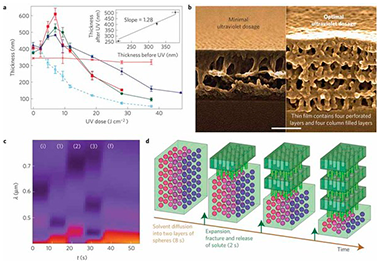Artículos SCI
2012
2012
Materiales Ópticos Multifuncionales
Collective osmotic shock in ordered materials
Paul Zavala-Rivera, Kevin Channon, Vincent Nguyen, Easan Sivaniah, Dinesh Kabra, Richard H. Friend, S. K. Nataraj, Shaheen A. Al-Muhtaseb, Alexander Hexemer, Mauricio E. Calvo & Hernan MiguezNature Materials, 11 (2012) 53–57
Show abstract ▽

Osmotic shock in a vesicle or cell is the stress build-up and subsequent rupture of the phospholipid membrane that occurs when a relatively high concentration of salt is unable to cross the membrane and instead an inflow of water alleviates the salt concentration gradient. This is a well-known failure mechanism for cells and vesicles (for example, hypotonic shock) and metal alloys (for example, hydrogen embrittlement). We propose the concept of collective osmotic shock, whereby a coordinated explosive fracture resulting from multiplexing the singular effects of osmotic shock at discrete sites within an ordered material results in regular bicontinuous structures. The concept is demonstrated here using self-assembled block copolymer micelles, yet it is applicable to organized heterogeneous materials where a minority component can be selectively degraded and solvated whilst ensconced in a matrix capable of plastic deformation. We discuss the application of these self-supported, perforated multilayer materials in photonics, nanofiltration and optoelectronics.
Enero, 2012 | DOI: 10.1038/nmat3179
Materiales de Diseño para la Energía y Medioambiente
Microstructure, composition and P-T conditions of rutile from diamondiferous gneiss of the Saxonian Erzgebirge, Germany
Escudero, A; Miyajima, N; Langenhorst, FChemie der erde-geochemistry, 72 (2012) 25-30
Show abstract ▽

The chemical composition and microstructure of rutile grains in a ultra-high pressure metamorphic gneiss of the Saxonian Erzgebirge, Germany have been studied by Raman spectroscopy, SEM, EMPA and TEM. Rutile inclusions in garnet contain free dislocations, iron-enriched dislocations and exsolved ilmenite lamellae, while subgrain boundaries are observed in rutile grains of the rock matrix. The previously reported alpha-PbO2 type TiO2 phase could not be confirmed by our TEM observations. On the basis of Zr solubility in the rutile and the presence of microdiamonds, minimum metamorphic peak conditions of 3.95 GPa and 915 degrees C are estimated.
Enero, 2012 | DOI: 10.1016/j.chemer.2011.11.001
Química de Superficies y Catálisis
Preferential oxidation of CO (CO-PROX) over CuOx/CeO2 coated microchannel reactor
Laguna, OH; Ngassa, EM; Oraa, S; Alvarez, A; Dominguez, MI; Romero-Sarria, F; Arzamendi, G; Gandia, LM; Centeno, MA; Odriozola, JACatalysis Today, 180 (2012) 105-110
Show abstract ▽

The general aspects of the synthesis and characterization results of a CuO x/CeO 2 catalyst were presented. In addition the principal steps for manufacturing a microchannel reactor and for the coating of the CuO x/CeO 2 catalyst onto the microchannels walls, were also summarized. The catalytic activity of this microchannel reactor during the preferential oxidation of CO (CO-PROX) was evaluated employing a feed-stream that simulates a reformate off-gas after the WGS unit. Two activation atmospheres were studied (H 2/N 2 and O 2/N 2). The reducing pretreatment improved the resistance to deactivation by formation of carbonaceous species over the catalyst surface at high temperatures. The presence of H 2O and CO 2 in the feed-stream was also analyzed indicating that the adsorption of CO 2 inhibited the conversion of CO at lower temperatures because these compounds modified the active sites through the formation of carbonaceous species on the catalyst surface. Finally, the experimental results of the microreactor performance were compared with CFD simulations that were carried out using a kinetic for the CuO x/CeO 2 powder catalyst. The experimental results were reasonably well described by the model, thus confirming its validity.
Enero, 2012 | DOI: 10.1016/j.cattod.2011.03.024
Reactividad de Sólidos
Non-isothermal microcalorimetric evaluations in quenched and in cold-rolled Cu-9Ni-5.5Sn alloys
Donoso, E; Dianez, MJ; Criado, JMRevista de Metalurgia, 48 (2012) 67-75
Show abstract ▽
The thermal aging of both a quenched and a cold rolled homogeneous supersaturated Cu-9 % wt Ni-5.5 wt % Sn alloy has been studied from differential scanning calorimetry (DSC) and microhardness measurements. An increase of the hardness during the aging of the quenched sample, because of the precipitation of a γ' phase, takes place. On the contrary, no hardness increase was observed during the aging of the cold rolled sample. A theoretical analysis of the enthalpy determined from the first DSC exothermic peak suggests that a segregation of the solute towards the dislocations occurs during the aging of the cold rolled alloy. The values of the n Avrami-Erofeev coefficients estimated from the kinetic analysis supports the above interpretations.
Enero, 2012 | DOI: 10.3989/revmetalm.1136
Química de Superficies y Catálisis
DRIFTS study of methanol adsorption on Mg-Al hydrotalcite catalysts for the transesterification of vegetable oils
Navajas, A; Arzamendi, G; Romero-Sarria, F; Centeno, MA; Odriozola, JA; Gandia, LMCatalysis Communications, 7 (2012) 189-193
Show abstract ▽

Mg-Al hydrotalcites rehydrated after calcination are promising catalysts for the methanolysis of vegetable oils. To gain insight into the basis of their catalytic action, the adsorption of methanol over some commercial Mg-Al hydrotalcites was studied by diffuse reflectance infrared Fourier transform spectroscopy (DRIFTS). Different species formed after methanol adsorption were identified, being the total quantity of methoxy species related to the basic character of the sample. A linear correlation between the amount of adsorbed monodentate methoxy species and the catalytic activity in the biodiesel production was found. Therefore, it is proposed that these species are the mainly involved in the transesterification reaction.
Enero, 2012 | DOI: 10.1016/j.catcom.2011.11.005
- ‹ anterior
- 342 of 422
- siguiente ›














